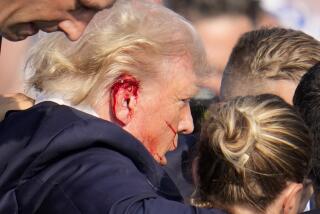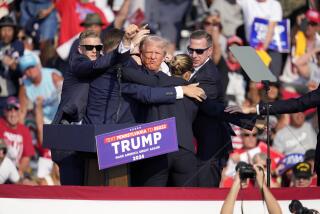New Study Says Shot From Grassy Knoll Likely
- Share via
WASHINGTON — The House Assassinations Committee may have been right after all: There was a shot from the grassy knoll.
That was the key finding of the congressional investigation that concluded 22 years ago that President Kennedy’s murder in Dallas in 1963 was “probably . . . the result of a conspiracy.” A shot from the grassy knoll meant that two gunmen must have fired at the president within a split-second sequence. Lee Harvey Oswald, accused of firing three shots at Kennedy from a perch in the Texas School Book Depository, could not have been in two places at once.
A panel of the National Academy of Sciences disputed the evidence of a fourth shot, contained on a police recording of the sounds in Dealey Plaza that day, and insisted that it was random noise, perhaps static, recorded about a minute after the shooting while Kennedy’s motorcade was en route to Parkland Hospital.
A new, peer-reviewed article in Science and Justice, a quarterly publication of Britain’s Forensic Science Society, says the NAS panel’s study was seriously flawed, having failed to take into account the words of a Dallas patrolman that show the gunshot-like noises occurred “at the exact instant that John F. Kennedy was assassinated.”
In fact, the author of the article, D.B. Thomas, a government scientist and JFK assassination researcher, said it was more than 96% certain that there was a shot from the grassy knoll to the right of the president’s limousine, in addition to the three shots from a book depository window above and behind the president’s limousine.
Former House Assassinations Committee chief counsel G. Robert Blakey said the NAS panel’s study always bothered him because it dismissed all four putative shots as random noise even though the three sound bursts from the book depository matched up precisely with film of the assassination and other evidence such as the echo patterns in Dealey Plaza and the speed of Kennedy’s motorcade.
“This is an honest, careful scientific examination of everything we did, with all the appropriate statistical checks,” Blakey said of Thomas’ work. “It shows that we made mistakes too, but minor mistakes. The main thing is when push comes to shove, he increased the degree of confidence that the shot from the grassy knoll was real, not static. We thought there was a 95% chance it was a shot. He puts it at 96.3%. Either way, that’s beyond a reasonable doubt.”
Physicist Norman Ramsey of Harvard, chairman of the NAS panel, said he was “still fairly confident” of his group’s work, but he said he wanted to study the Science and Justice article carefully before making further comment.






